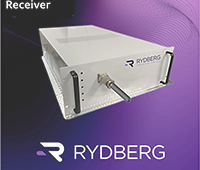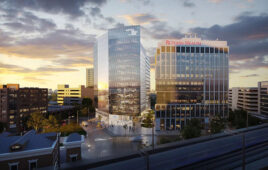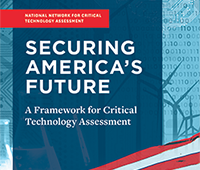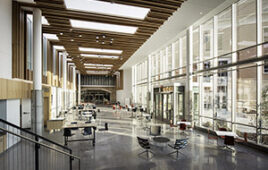NREL’s data center is arranged with hot aisle containment. As the server equipment is cooled, it pulls air from the room through the front of the cabinet and blows warmed air out the back of the equipment air into the containment aisle. Credit: Dennis Schroeder |
Data
is something computer users often take for granted. As you type, an
unimaginable quantity of ones and zeros fly through networks and
cyberspace and are parsed together into documents, photos, music,
websites and more.
All
of those ones and zeros have to live somewhere and their “home” often
is business data centers. Like any home, data centers use energy — and
lots of it. The current estimate is that data centers account for as
much as 3 percent of the nation’s energy use. In 2006, the EPA published a report
forecasting that by 2011, “national energy consumption by servers and
data centers could nearly double … to more than 100 billion kWh,
representing a $7.4 billion annual electricity cost.”
The
data center for the U.S. Department of Energy’s National Renewable
Energy Laboratory (NREL) recently benefited from an “extreme home
makeover” as it moved from leased office space to the lab’s ultra energy
efficient Research Support Facility (RSF). The lessons learned will
help data centers around the world green up their ones and zeros.
How good is your PUE?
Power
usage effectiveness (PUE) is a key metric for determining how green a
data center is and it shows how effectively a data center uses power.
PUE is the ratio of the total amount of power used in the data center
divided by the amount of power to the computer equipment. The best score
a data center can earn is 1.0.
“Our
PUE has gone from 3.3 in our old location to 1.15 at the RSF; last
month our average was 1.12,” NREL Manager of IT Infrastructure and
Operations Group, Chuck Powers said. “A data center is typically
considered world class when the PUE reaches 1.3 — we’ve redefined world
class. We had a lot to live up to and we’ve been successful.”
Like
most projects related to NREL’s RSF, the beauty of the energy solutions
are in their simplicity. While NREL had the advantage of building the
data center from the ground up, the practices applied can be used in
data centers new and old including:
- Managing air flow — optimizing it and reusing it
- Using energy-efficient cooling techniques
- Increasing operating temperatures
- Upgrading power back-ups
Managing air and reusing it
TUnorganized cables impede airflow and keep hot air from being blown past the cables. As part of its energy efficiency practices, NREL organizes the cables in back of the cabinets. Credit: Dennis Schroeder |
Airflow
management is very important to greening a data center. “The back of a
server rack often looks like a bowl full of spaghetti noodles,” Powers
said. “All of those cords everywhere impedes air flow and keeps the hot
air from being blown past the cables. We are very careful to organize
the cables in back of the cabinets.”
At
NREL, it might be said that the lab has taken aggressive measures to
manage airflow, including setting up the aisles so that the cool air and
warm air do not mingle.
The
data center is arranged with hot aisle containment. As the server
equipment is cooled, it pulls air from the room through the front of the
cabinet and blows warmed air out the back of the equipment (warm
aisle). The RSF data center has the backs of server rows facing each
other and the aisle has a ceiling over it and vents to capture the warm
air.
“Because
of the way we’ve contained the heat, we are able to use the heat from
the data center to heat the RSF,” Powers said. For the first Colorado
winter in the RSF, the data center provided a significant amount of
heating for the 222,000 square foot facility.
“The
hot air from the hot aisle in the data center is 80°F all winter,” NREL
Senior Research Engineer Shanti Pless said. “In the winter, we used
this waste heat for heating of the RSF’s outdoor air during the day, and
at night when the RSF ventilation system is off, it goes to heating the thermal mass in the labyrinth,
so that this otherwise wasted heat is available the next day. It is a
simple, yet elegant solution that utilizes the building’s concrete
structure as a thermal battery.”
Hot
air used to be the bane of data centers, but not anymore. Walking into a
1980s server room often required adding a sweater because the
facilities were kept cool to keep the machines from over-heating.
“Today’s servers can tolerate more heat, with a recommended temperature
range of 60–80°F with less than 60 percent humidity,” Powers said.
“Increasing the operating temperature to 80°F means you need
significantly less cooling and energy. We are continually monitoring our
data center temperature to get that number up as high as possible,
without impacting our servers.”
Mother Nature has a cool role
A
warmer data center means that in cooler climates like Colorado, Mother
Nature can provide natural air conditioning for most of the year.
Because of Colorado’s cool and dry climate, NREL can just use direct, filtered, air drawn in via this intake, to cool the data center 70%of the year. Credit: Dennis Schroeder |
“You
really have to take an inventory of the natural resources available and
leverage those resources to help reduce the cooling, or the power load,
for your data center,” Powers said. “In Colorado, 70 percent of the
year we can just use direct, filtered, air to cool the data center.
Roughly 30 percent of the year, we can use an energy efficient
evaporative cooling to cool the air a little further. There are only an
average of 33 hours a year where we see a combination of high heat and
humidity that require chilled water to cool the air.”
Colorado
also has the advantage of an average of 300 days a year of sun.
Photovoltaics (PV) are installed on the roof of the RSF and related
parking structures. The combined 2.5-megawatt system will offset the
annual energy usage for the entire RSF, the parking areas, and the data
center.
Boosting equipment energy efficiency
Moving the data center provided NREL with the opportunity to replace equipment to increase its energy efficiency.
“I
had two years to begin the whole replacement cycle before our data
center moved to RSF,” Powers said. “We replaced traditional servers with
blade servers — that saved us 30 percent on our power. We also were
able to virtualize, or take the workload that used to run on 20 or more
servers and put it on one energy efficient blade. We went from 302 watts
per server to 10.75 watts per server at a 20:1 ratio, a significant
reduction in power requirements for servers.”
Another
major energy savings for NREL was found in the data center’s UPS or
back-up Uninterrupted Power Supply. NREL’s old UPS was 80 percent energy
efficient and the new one is 97 percent efficient.
“On
a 100 kilowatt (kW) load, right off the top we saved 17 kW, or a 17
percent reduction in energy consumption,” Powers said. “The old UPS
produced an additional 20 kW of heat that needed to be cooled. We are
experiencing a 19 percent reduction in our total data center power
requirements by replacing the UPS with one that is ultra energy
efficient.”
The
new data center has reduced NREL’s annualized carbon emissions for data
by almost 5 million pounds per year and operating costs by $200,000 per
year.
Much
of what was done at NREL can be repeated in any data center. “There is
tremendous opportunity here for retrofits as well,” Powers said. “NREL
is now being asked to help other organizations optimize their data
centers. A lot of what we have done can significantly improve the energy
efficiency in existing data centers, and many of the practices can be
implemented at low cost.”







